|
|
Post by codystarbuck on Oct 3, 2019 20:12:34 GMT -5
The Nude Bomb is a riot and I find it one of the silliest movie made at that time and I just felt that Dana Elcar was perfect as Chief. I was totally surprised to see Sylvia Kristel in this movie. This movie was a total riot and its quite effective as a comedy. I was total surprise to see that the reviews were bad, downright horrible, and shocked that most of the general audiences except me enjoyed it. I thought it had some good moments; but, there was also a lot of it that fell flat, to me. The lack of Barbara Feldon was a big deal nd Sylvia Kristel wasn't the greatest, when trying to act in English. She's in The 5th Musketeer and she's rather flat, in her dialogue. In fact, in that film, between her and Ursula Andress, it's a pretty bad film on the female side, saved by Olivia de Havilland, as Queen Ann. Kristel was beautiful; but, she was better in French or Dutch. The tv movie, Get Smart Again had people who knew what Get Smart was all about and everything didn't hang on Adams. Like I say, it has moments and isn't as bad as critics made it seem; but, it wasn't the tv show, either. |
|
|
|
Post by berkley on Oct 3, 2019 22:41:39 GMT -5
I loved the show as a kid and as Brutalis said, me and my friends would quote the catchphrases and favourite scenes to one another endlessly.
I don't think I ever knew there was a Get Smart tv movie, must look out for that, especially since it reunited the two stars. Haven't seen the recent remake, not too interested in it, though I like Johnson/the Rock and have a mildly positive impression from the little I've seen of Steve Carroll.
I saw the Nude Bomb at the theatre when it came out but don't remember much about it: my general impression is that it wasn't terrible, certainly not deserving of that nomination for worst film of the year. If nothing else, it was nice to see Don Adams playing the character again. Kristel was not a worthy replacement for Feldon, I agree - and why replace her anyway? I never really felt Kristel's appeal, to be honest, and sort of had the uncharitable idea that her fame was all due to appearing in those Emmannuelle movies (a light erotic European film series, for anyone too young to know what I'm talking about).
But this is probably just a personal blind spot - like codystarbuck's inexplicable (to me) disdain for the immortal Ursula Andress (have never seen the Fifth Musketeer, but I can watch Ursula Andress in anything, so it's definitely on my list of things NOT to avoid!).
|
|
|
|
Post by codystarbuck on Oct 4, 2019 10:54:10 GMT -5
I loved the show as a kid and as Brutalis said, me and my friends would quote the catchphrases and favourite scenes to one another endlessly. I don't think I ever knew there was a Get Smart tv movie, must look out for that, especially since it reunited the two stars. Haven't seen the recent remake, not too interested in it, though I like Johnson/the Rock and have a mildly positive impression from the little I've seen of Steve Carroll. I saw the Nude Bomb at the theatre when it came out but don't remember much about it: my general impression is that it wasn't terrible, certainly not deserving of that nomination for worst film of the year. If nothing else, it was nice to see Don Adams playing the character again. Kristel was not a worthy replacement for Feldon, I agree - and why replace her anyway? I never really felt Kristel's appeal, to be honest, and sort of had the uncharitable idea that her fame was all due to appearing in those Emmannuelle movies (a light erotic European film series, for anyone too young to know what I'm talking about). But this is probably just a personal blind spot - like codystarbuck's inexplicable (to me) disdain for the immortal Ursula Andress (have never seen the Fifth Musketeer, but I can watch Ursula Andress in anything, so it's definitely on my list of things NOT to avoid!). I don't have disdain for Andress; I am speaking specifically of the 5th Musketeer. She is rather stilted in her dialogue. |
|
|
|
Post by codystarbuck on Oct 6, 2019 23:32:39 GMT -5
Now, one very special rival of James Bond, who never got her just deserts in other media..... Modesty Blaise.  In the wake of the success of Bond in film, everyone wanted in on the action. Comic strip writer Peter O'Donnell had an idea swirling around, based on a young girl he met during WW2, in the Middle East, O'Donnell concocted the strip Modesty Blaise. Modesty was a war orphan and refugee, who befriended a Hungarian Jew, who had been a professor, at a displaced persons camp, in Greece. Together, they left the camp and travelled throughout the Mediterranean and North Africa, the teacher, Lob, opening Modesty's mind to all kinds of subjects, while Modesty, who had a PD insurvival, found them food and shelter and protected them. Lob quietly died and Modesty made her way to Tangiers, Morocco, where she became a croupier in a casino, run by gangsters. When the gang boss was killed, it was Modesty who pulled together the strings of the gang and created The Network, a criminal gang that became the most feared and successful in Europe and surrounding regions. Modesty travelled to Thailand and observed a British man (Willie Garvin) fight in muy thai bouts, then bailed him out of jail; no strings attached. She offered him a job, if he cleaned up his act. otherwise, he could continue to drink himself to death and she would move on. He rediscovered the spark that he had lost, cleaned up and became her right hand man. Together, they and The Network became the biggest deal around. However, The Network did not deal in vice or human misery. They did not do contract murder, run drugs, engage in prostitution, human trafficking, violent crime, or anything else that preyed on human weakness. Theft, con games, insurance fraud, and high end crimes were another story. they also trafficked in intelligence, though they never operated against the interests of the British government, as Modesty planned to retire there. When they made their fortune, Modesty and Willie retired to England; Modesty to London, Willie to a pub along the Thames. They grew bored in their retirement and were approached by intelligence chief Sir Gerald Tarrant to help with a case. This led to a long association between Modesty, Willie and Tarrant. Together, the pair take on criminals, enemy spies, murderers, madmen and vicious thugs, always with brains, guile, and skill. Modesty was a kick-ass heroine, who was feminine, yet capable in a fight. She was the brains, Willie was her sidekick. They were not lovers. Willie adored the Princess (as he called her) for saving his life (rescuing him from alcoholism, though they have literally saved each other too many times to count). it isn't sexual; he worships her. Modesty returns the affection; Willie is family. She has friends and lovers; but, Willie is not a bed companion. The strip featured terrific plots, plenty of hard-hitting action, and the ebst of the Bond world, done in better style and wit. Modesty didn't need to be rescued; even handcuffs didn't subdue her...  She was an expert pistol marksman, archer, fencer, and master of the kongo (or yawara stick), a small hand weapon. Willie was a knife throwing and fighting expert; possibly the best in the world. he was also well versed in the martial arts, including muy thai, which emphasizes fast kicks, punches, knee and elbow strikes, from close quarters positions. Willie is also a crack marksman with a rifle and pretty fair with a pistol. he also is a master of electronics and concocts gadgets for their missions. Initially, Frank Hampson (of Dan dare) worked on the development of the strip; buy, O'Donnell didn't like how it was turning out. He turned to former collaborator Jim Holdaway to take over. The pair had worked on a popular, light-hearted detective strip, Romeo Brown. 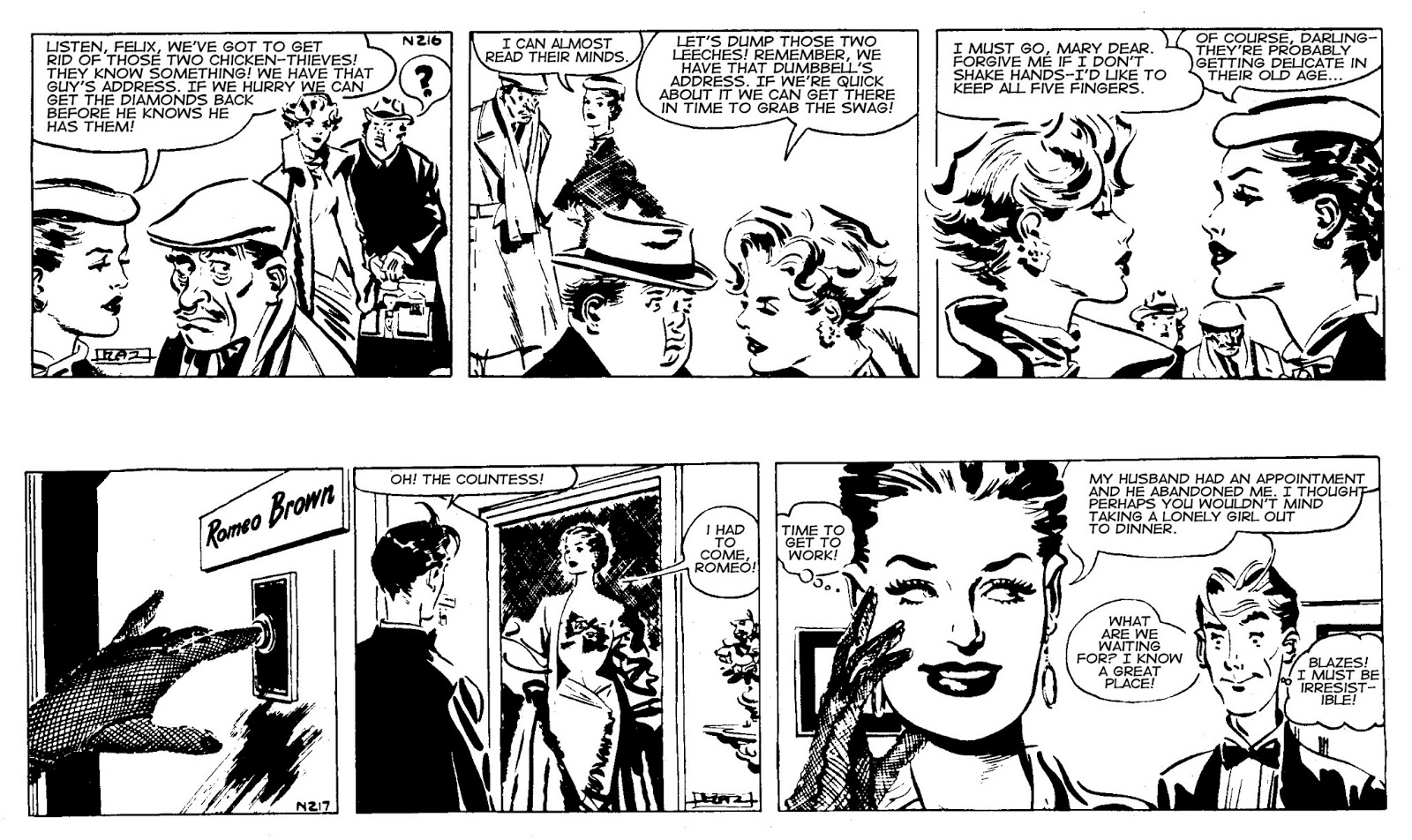 They began with a bang, with the first story, "La Machine," where Modesty takes on a criminal gang...  The strip premiered in The Evening Standard, in 1963 and were soon syndicated around the world. It didn't take too long for film offers to come along. british agent Mim Scala had optioned it and wanted to have Barbara Steele play Modesty and Michael Caine to play the Cockney Willie Garvin.... 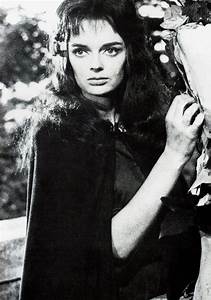 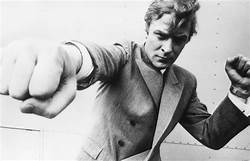 Scala made the mistake of selling the rights to produce the film to Joseph Janni, who had director Joseph Losey and Italian Monica Vitti as clients. he chose to have Losey direct and Vitti star, as Modesty. He ignored the fact that Vitti was blond, and Losey was more of a politically oriented director. he also ignored the script that Peter O'Donnell wrote, which got passed through numerous hands, until only one line of the original dialogue was left (per O'Donnell). Losey and Janni wanted to do a camp satire and focused more on surreal visuals and bizarre characters, rather than serious adventure. The end result was 1966's Modesty Blaise... The film features Vitti as Modesty, while Terrance Stamp is Willie Garvin. Dirk Bogarde is the villain, Gabriel, and Harry Andrews is Tarrant. Clive Revill plays both Gabriel's henchman, McWhirter and Sheik Abu Tahir. The plot has Tarrant approach Modesty to protect a diamond shipment, meant for her old friend Abu Tahir, from the criminal mastermind Gabriel. She recruits Willie Garvin and they head to Amsterdam, where Modesty links up with an ex-lover, MI-6 agent Paul Hagen and Willie finds old flame, nicole. Paul & Modesty are attacked by Gabriel's thugs, and Willie and tarrant rescue them. Nicole is murdered and Willie and Modesty kill the assassins. they set themselves up as bait, to draw out Gabriel. Modesty is taken prisoner and Willie is forced to help steal the diamonds. Modesty is wooed by Gabriel and, with Willie's help, escapes, killing Gabriel's assassin Mrs Fothergill. Modesty gets word to Abu Tahir, whose soldiers storm gabriel's island and defeat his goons. Modesty turns the diamonds over to the sheik and then names her reward; the diamonds. Starting with the good, you have an excellent cast of actors. Terrance Stamp was a perfect choice for Garvin. Bogarde makes for an interesting, if quirky villain. Clive Revill adds comedic touches. Unfortunately, that's about it. there are some humorous scenes; but, the bulk ends up bizarre, at best, and boring, at worst. More attention is paid to modern decor, fashion, pop art graphics, bright colors, and art design. Little attention was paid to whit or real satire; certainly not to adventure and action. Fight scenes show little or no fight choreography and even Willie Garvin's knife tricks are mundane. Willie is presented more as the hero, with Modesty more of a victim, who gets a few shots in. She is more a playful sprite, bouncing around in high fashion outfits, charming people, without ever doing much. She certainly isn't deadly. There is a sequence, when Modesty is hiding in Paul's apartment and she pops out dressed like Jim Holdaway's Modesty, complete with black action outfit, holstered pistol, and bow and arrow... 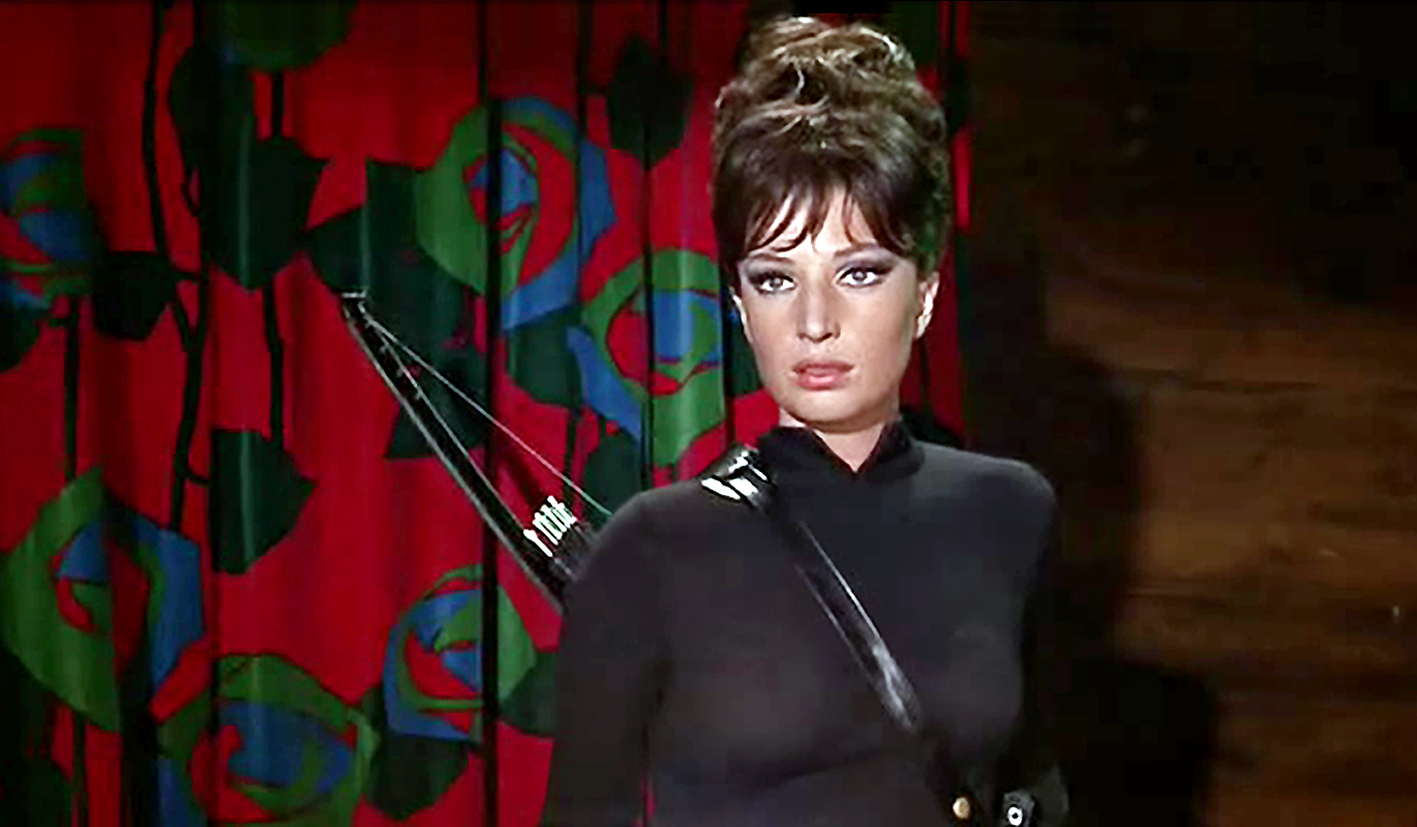 She looks the part there and even O'Donnell couldn't fathom why they didn't stick with the look. You also see Modesty comics in Paul's pad, for a sort of meta-commentary. the sequence has Paul asking Modesty how she gets into and out of the outfit, which just plays as silly, not comedic. When gabriel's goons show up, Modesty is taken in the bath and tied up in a rug, while Paul has also been neutralized. Modesty doesn't even get in a judo throw, before she is rescued by Willie. in the strips, Modesty is often captured and Wille helps her get freed; but, she usually gets in her own licks before and after. Often, the tables were turned and Modesty rescues the captured Garvin. Dirk Bogarde plays Gabriel as a sort of bored camp figure (as in gay camp), who somehow still lusts after Modesty. Mrs Fothergill is a dominatrix/possible lesbian (definitely, in O'Donnell's script), who tortures then kills a mime,at one point. Sir Gerald woos Modesty in a handsome cab, to get her to help, which is definitely not how Modesty and Tarrant's relationship was in the strip. Sir Gerald respects Modesty and treats her like a professional, while also adoring her like a daughter. In the novel, Silver Mistress, Modesty rescues a captured and tortured Tarrant, showing just how much she cares for the man, beyond their professional relationship. he is like a father to her; or, at least, a favorite uncle. Modesty and Willie go off together, in the film, which definitely wasn't how they were portrayed in the source. I wouldn't mind the changes, if the film were actually funny. This was part of the whole mod/camp film style that was en vogue, with films like Casino Royale, Diabolik, Barbarella and similar fare. However, Barbarella and Diabolik managed to be both funny and exciting as adventure pieces (in varying degrees), while Casino Royale had some funny moments, while sending up the whole idea of Bond. It failed and the film is a hot mess; but, it is Citizen Kane by comparison to modesty Blaise. The Italians did it better and british films managed better swinging films, like Alfie, Blow Up or some of the others, of the period. Stamp is wasted, as his menacing stare and predatory acting style was perfect for someone as dangerous as Garvin; but, it never comes off. He isn't great at comedy, though he would grow into it, by the time he did The Adv. of Priscilla, Queen of the Desert. Vitti would work with Michelangelo Antonioni; but, this is not her best moment. Even Dirk Bogarde, a fine actor, has trouble with this script. It is definitely not an adventure film and it is not a good adaptation of Modesty Blaise. About all they used were character names. Peter O'Donnell, disgusted with the film, took his screenplay and turned it into a novel, titled Modesty Blaise, which became a smash hit. It also features gabriel and a plot to steal diamonds; but, has Modesty and Garvin acting in character, in an exciting and thrilling adventure. That would launch a whole series of novels, 11 in total, plus two story collections (Pieces of Modesty, The Cobra Trap), between 1965 and 1996. The Cobra Trap features an ending for Modesty and Willie, while the comic strip ended in 2002, with Modesty and Willie going off to recover some buried treasure and a break from violence. This wasn't the only attempt to adapt Modesty Blaise. In 1982, a tv pilot was produced, with Ann Turkel as Modesty, and Lewis Van Bergen as Willie Garvin, with Keene Curtis as Tarrant. it was played straight but had little to distinguish it from other pilots. Turkel was a former model, turned actress, who was more famous as the wife of Richard Harris (they would divorce in 1982) and appeared with him in The Cassandra Crossing. She is a pretty bland Modesty, who has an American accent and lives in what appears to be LA. Van Bergen was a minor actor in television, whose biggest claim to fame was starring in Sable, the tv series based on Mike Grell's Jon Sable, Freelance comic. It lasted 7 episodes and was noted only for being an early role for Renee Russo, as Eden Kendall. The pilot has Tarrant recruit Modesty and Willie to protect a young woman, who is a computer genius, from terrorists. The pilot opens in a restaurant, where Modesty is attacked and rips her skirt for better movement to fight. This was a common feature of the strip, which was promising. however, a pair of bland leads, and a character actor who had done a lot of mediocre tv was not a star-making formula. The plot is run-of-the-mill and mirrored dozens of adventure tv shows already on tv. turkel had neither charisma or talent to pull of Modesty and it ended up being a footnote. 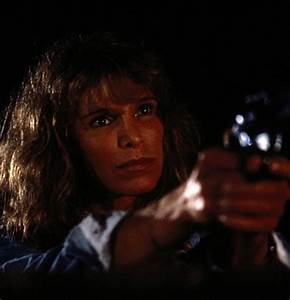 The next iteration of Modesty, aside from reprints, was a graphic novel, from DC Comics...  The comic is adapted from O'Donnell's novel and movie script and is credited to him and Dick Giordano. However, Dan Spiegle ghost-pencilled the majority of it, with Giordano inking, due t time constraints. it looks mostly like Giordano, though there are portions which scream Spiegle. Either way, Spiegle and gordano were perfect for the material (Spiegle's Crossfire was a tremendous adventure comic and he had done Maverick, for Western/Gold Key, as well as the revival of Giordano's The Secret Six). This, too, was barely a blip on the radar, as DC did little to promote it beyond a house ad that also ran in trade publications. being a Modesty fan, I pounced on it, when I saw it in Advance and had a copy with a bookplate, signed by Peter O'Donnell, from Bud Plant's catalog. That was about it, apart from one odd Modesty sighting...  In Quentin Tarantino's film, Pulp Fiction, Vincent Vega can be seen reading the hardcover edition of the original Modesty novel. Tarantino was a huge fan, who said the film was a great Joseph Losey film, but a terrible Modesty Blaise film. I don't know about the former; but, the latter was true. Tarantino was keen to adapt Modesty and played around with the rights, for a while. However, he was always distracted by other things. To keep the film rights alive, Harvey Weinstein (who Modesty would have turned into a stain on the floor) hired Scott Spiegel to direct a direct-to-video film, that would serve as a prequel. That film was 2004's My Name is Modesty... The film features Alexandra Staden, a British actress, as a young Modesty, not yet a crime lord. It features Modesty working as a croupier in a casino, which is taken over by criminals (led by GOT Nikolaj Coster-Waldau). Also featured is Raymond Cruz (Tour of Duty, Clear & Present Danger) . Modesty tells of her life story as she plays roulette against Coster-Waldau. We see young Modesty, orphaned by the wars in the Balkans, following the break up of Yugoslavia. She meets Lob and befriends him, surviving on their wits, until his death. from there, she ends up in a casino. By the end, she will be running the casino and associated businesses. The film is actually pretty good, as these things go. It is fairly faithful to modesty's origin, which was revealed in the strip as "In the Beginning." The story is updated from WW to the Balkan conflicts, which fit in perfectly. It was shot in Romania, which has the right setting. Staden proves a decent actress and Coster-Waldau was already excellent. However, Staden is so distractingly anorexic as to be alarming. It works fine for flashback scenes, where she is hungry and scarred. it doesn't work when she is supposed to be a healthy adult. You can't help seeing her and thinking, "Someone get her a sandwich!" This was supposed to be the first of a series of Modesty films; it was the only one. There have been other noises of a Modesty film; but, nothing has come of them. It's sad, as Modesty has pre-storyboarded adventures for a fantastic series of films. With a top actress and a serious writer and director, it would be a female-led film franchise that could draw a massive audience, especially women. I always thought Luc Besson could have done a fantastic film, based on La Femme Nikita. At that time, I thought of either Anne Parillaud (star of Nikita) or Madeline Stowe as Modesty, with Sean Bean as Willie Garvin, with Christopher Plummer as Tarrant. These days? I don't know. Next time, we look at a few other spy spoofs, as we round out the 60s. |
|
|
|
Post by berkley on Oct 7, 2019 23:22:06 GMT -5
Huge fan of the books and to a lesser degree the newspaper strip. Haven't seen any of the film versions as they all looked so bad, apart from the the Italian one, which I might watch some day since there's a chance I could be able to enjoy it as a piece of 60s spy-nonsense, though not as a Modesty Blaise movie.
I'd heard about Caine being thought of for Garvin but not that Barbara Steele was up for the part of Modesty Blaise. Apparently O'Donnell himself did think Caine was a good choice for Willie Garvin, but I must admit I don't think he would have been quite right. I can more easily see Steele as Blaise, but of course you never know until you actually see the end result. It sounds good on paper, at least.
Of modern actresses, yeah, tough call. I think Gemma Chan, has the right aura and screen presence, though I'm not sure how she'd do with the action stuff, etc: if it were anyone else with her tall, slender body type I'd dismiss the idea, but she has a way of carrying herself on screen that I think could make it work. But then, I think she should be in every movie, it seems.
Re the comics, I rate the Holdaway era way above the Romero, as far as the artwork goes. Not that there's anything wrong with Romero's stuff, but it doesn't quite click with me like Holdaway's does. I haven't seen enough of the Neville Colvin strips to judge for sure, but I'd tentatively rate him 2nd after Holdaway and before Romero.
And I love the samples I've seen of Al Williamson's audition for the strip, I think he would have been perfect for it, maybe even better than Holdaway, though only time would have been able to tell. Admittedly, I'm a huge fan of his work, so again, it could be my personal taste is blinding my judgment, as with the idea of Gemma Chan as Modesty Blaise. I read somewhere that O'Donnell said years later that he would have picked Williamson as Holdaway's successor after the latter's early death but there was some mix-up and he never saw the sample strips Williamson submitted.
I don't like the looks of the Spiegel/Giordano comic and have avoided it.
|
|
|
|
Post by Rob Allen on Oct 8, 2019 13:32:31 GMT -5
I remember watching the debut of Get Smart. My father had read something about it and said he was looking forward to it. But he didn't tell us anything about it except the title. To me and my brother, "Get Smart" sounded like some kind of educational show, so we had no idea what was coming when the show started. The whole family loved the show and watched it every week for the next few years.
|
|
|
|
Post by codystarbuck on Oct 10, 2019 12:20:24 GMT -5
So, the world of spies wasn't just limited to adventure films. There were the spy spoofs, comedies that would parody spy film conventions; but, it didn't stop there. Even romantic comedies took on the trappings of spy films, as well as screwball comedies and pseudo-beach films. Fathom was British film, done to cash in on Modesty Blaise (which was a hit in the UK and Europe, but did so-so in the US). They got the director and writer of the Batman film and slapped together a vehicle for a young Raquel Welch. The plot has American skydiver Fathom Harvill recruited by the head of a NATO intelligence unit to skydive into a millionaire's hacienda, to locate the triggering mechanism for a hydrogen bomb. She ends up caught between opposing sides, while spending amazing amounts of time in bikinis and skimpy outfits. Welch, herself says she was little more than a Barbie doll and she is pretty bad in this. Tony Franciosa isn't winning any points, either. The British character actors (Roy Frazier, Richard Briers, Clive Revill) are the only decent ones; but, the script is filled with unfunny junk, senseless action scenes, and a mess of a pot. It is even less campy than Modesty Blaise. Welch had a fight with the director on the first day and wouldn't speak to him for the rest of filming. Director Leslie Martinson and writer Lorenzo Semple Jr were hired because they had made Batman quickly and cheaply. Well, this one was done cheaply and quickly and badly. The Second Unit Director actually defended Welch, saying she was inexperienced; but, watched the rushes every day and learned from them. Welch did, eventually, become a decent actress (within a limited range) Here, she was the lead for two reasons and they were shot at angles that emphasized them. Fathom tanked in the US; but has a cult following. It is a bit weird to see Richard Briers as a spy, after years of tv characters like Tom Good, in The Good Life/Good Neighbors... 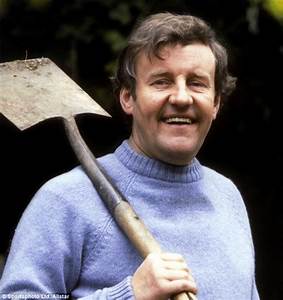 Granted, those tv roles came after and briers was an accomplished stage actor. Also getting into the camp spy game was Troy Donahue (though not in that way...) and Andrea Domm, in Come Spy With Me... Dromm is the spy, who must foil a plot to blow up world leaders with an underwater bomb. Troy Donahue is the romantic interest and his wife, of the time, also appears. The villain is played by Albert Dekker, of Dr Cyclops fame. It was not a hit and is best known for the theme song, from Smokey Robinson & the Miracles. Doris Day even got into the game, though not willingly. She did the movie Caprice, where she is an industrial designer at a cosmetics company, who gets mixed up in industrial espionage, which turns out to involve a plot to introduce a narcotic agent in the cosmetics. The film tanked at the box office and Day regretted it. Her husband and agent had signed the contracts without her knowledge and she was furious. The script was heavily changed to suit her and ex-Looney Tunes animation director Frank Tashlin helmed the film, focusing on comedy and slapstick. The end result didn't help, though it acquired a cult following for the look of things, with its Mod design and slapstick scenes. Tashlin and Day were also paired in a more successful film, which blended her normal romantic comedy with spy elements. Day is Jenny Nelson, a widow and tour guide for Templeton Aerospace. Her father runs a glass-bottom tour boat, off Catalina and Jenny swims by in a mermaid costume as a stunt to attract the tourists. Rod Taylor is aerospace genius Bruce Templeton (think Tony Stark), who accidentally snags Jenny's mermaid tail, with his fishing line, leaving her bottomless. Later, she gets her heel caught in a cleaning grate at the plant and he tries to rescue her, only for trouble to unfold. templeton is smitten with her and concocts a project to have her work closely with him and charm her, which succeeds. meanwhile, a suspicious security officer notices Jenny making strange phone calls to someone named Vladimir (her dog). He thinks she is a spy and there is real worry about a top secret project at the plant. The film is great fun, with Rod Taylor as Templeton, Paul Lynde as the security officer, Dick Martin (as in Rowan & Martin's Laugh-In) as Bruce's partner, Dome Deluise as a spy, and Arthur Godfrey as Doris Day's father. The film is full of cartoon slapstick, some actual romance, intrigue, and wild antics. It also features Paul Lynde, in drag! Tashlin mixes the typical Doris Day formula with his Looney Tunes past and it works well. The film even features nosy neighbors, played by Alice Pearce and George Tobias, the original Gladys and Abner Kravitz, on Bewitched. Day gets to sing her requisite songs, with Godfre joining for a couple. There is a notable scene at a party, where we see Robert Vaughn, in a cameo.... Not to be outdone, AIP slapped together a mash-up of spy spoofs and beach films, with Frankie Avalon as a government agent, whose buddy Dwayne Hickman (Dobie Gillis) gets mixed up in things. AIP horror vet Vincent Price is the villain, Dr Goldfoot, who has created sexy female robots to seduce and rob wealthy men. This is a pretty dumb film and is very uneven; but, it has a goofy charm and some genuinely funny moments. The spy stuff is really minimal and it is more of a detective comedy/horror film than anything else. Vincent Price makes the good stuff work. A sequel followed, though on a smaller budget. Frankie and Dwayne are replaced by Fabian and a pair of Italian comics (Franco & Ciccio). The Italian comics were the stars for Europe, with Fabian added for the US. It was directed by Mario Bava (Diabolik, Planet of Vampires). They actually edited two versions; the American version emphasizes Fabian, with the comics as sidekicks, while the European version focuses more on the two comics. It was noticeably shot on a smaller budget and is vastly inferior to the first film, though Price is still having fun. Fabian is terrible and makes Avalon look like Brando. The first film also features a title song by the Supremes, with claymation titles from Art "Gumby" Clokey. Next, a French spy series that crossed a couple of generations, featuring American Cajun agent Hubert Bonisseur de la Bath, better known by his code name: OSS 117. We will see as a serious Eurospy series becomes a spy spoof series, with Academy Award-winning actor Jean Dujardin. |
|
|
|
Post by codystarbuck on Oct 13, 2019 22:10:44 GMT -5
Before James bond received his license to kill, there was already a deadly secret agent on the job: Hubert Bonisseur de la Bath, agent OSS 117. The character was the creation of author Jean Bruce, a prolific writer of pulp novels, who debuted the character in 1949, 4 years before Bond. OSS 117 would go on to appear in over 88 books, by Bruce, another 143 by his wife, and 23 by his daughter. Hubert is a Cajun American, working for the OSS, then the CIA and NSC. The novels were hard hitting adventure and a film series would follow, starting in 1956, with OSS 117 is Not Dead.  The film features Bonisseur coming to the aid of a friend, helping to recover secret documents. It can be seen on Youtube, in it's original black & white. With the success of Bond, OSS 117 would return to screens in 1963, with OSS 117 se Deschaine, starring former Sinbad and Jack the Giant Killer Kerwin Matthews. He would then follow up in the sequel, Banco a Bonkokpour OSS 117, aka Shadow of Evil. This time, Hubert travels to Thailand to investigate the death of a fellow agent, who was researching outbreaks of plague, in India. he soon discovers the epidemics were the work of Dr Sinn (not the Scarecrow) and infiltrates his lair, with the help of Dr Sinn's sister. Next was Furia a Bahia pour OSS 117, aka Mission for a Killer. Matthew is replaced by Frederick Stafford, as Hubert is interrupted while on a ski vacation by a series of suicide attacks, carried out by the assistants of the targets. OSS 117 travels to Brazil, where he fights assassins and tracks down a mind-altering drug, derived from South American flowers, which created the mind-controlled assassins. Atout coeur a Tokyo pour OSS 117, aka Terror in Tokyo was next, as Hubert travels to Japan to stop The Organization, a criminal group with a missile, who are blackmailing the US for $100 million. The film was an original, not an adaptation and featured a story by Bond director Terrence Young, with similar elements to You Only Live Twice, but before that movie was released. Pas de Roses pour OSS 117, aka OSS 117 Double Agent was next. 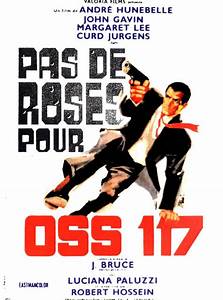 John Gavin took over the role, which sees the hero undergo plastic surgery to infiltrate the villains. This film proved less popular than previous entries, though it helped put John Gavin on the map as a potential Bond, before Sean Coonery was brought back for Diamonds Are Forever. OSS 117 Takes a vacation was the last film in the series and was a French/Brazilian co-production. Model Luc merenda took over the role and was signed for 5 films; but this was his only one. he would go on to do multiple police films, in Italy. The 1960s OSS 117 films are fine spy adventures, and were quite popular in Europe. they are among the best of the Eurospy genre and probably come the closest to delivering the thrills of the Bond series, though on a lower budget. There would be a tv movie, OSS 117 tue le taon, in 1971; but, that would be it for the hero, despite the book series continuing until 1992. However, that would not be the end of it. In 2006, director Michel Hazanavicius revived the hero, for a spoof of the old films and the genre, in general. He and co-writer Jean-Francois Halin set the story firmly in 1955 and made the hero a French secret agent. At the time, France was led by Rene Coty, who proved a massive failure, leading to the return of De Gaulle. One of the running gags finds OSS 117 trying to give a picture of Coty to various people, as a sincere gift, to their ambivalence. The film has Hubert tasked to investigate the death of old comrade Jack Jefferson, in cairo. A Soviet ship has docked there and Hubert soon finds himself in the middle of a spy game between ex-Nazis, Egyptians, the French, a Belgian spy, the Soviets, and a few others. The film stars Jean Dujardin, who brings the suave look to the character, but mixes in the comic timing of Peter Sellers and OSS 117 is pretty much a half-wit. The film pokes fun at the style of 60s spy adventures, recreating the look, the music, the fashions, and even the techniques, such as rear screen projection for vehicle scenes, day-for-night shooting (using filters over the lights), and the general nature of the action. Hubert is patriotic, insulting and totally oblivious to any offense he causes. In one hilarious scene, he is awakened by a muezzin, calling the faithful to prayer. He goes out to tell the man to be quiet, because people are trying to sleep... In another, he is trailing a suspect and is disguised as a musician and is called upon to play a song. He surprises himself by playing the italian song Bambino... Jack had used a warehouse as a front,which leads to a ridiculous series of scenes as Hubert deals with the hundreds of chickens inside, and an infiltrator, in the world's strangest game of Chicken... Dujardin is brilliant in the role, both playing the suave secret agent and the comic fool, wrapped up in one package. he is totally committed to the character and plays it wonderfully. it brings to mind Austin Powers; but, this is more of a loving tribute to the era and the style of things, while poking fun at the absurdity and stretch it into a broad cartoon, yet never dipping into the vulgarity that Austin Powers descended into, at times. The film became an international sensation and led to a sequel, in 2009: OSS 117: Lost in Rio. This time, OSS 117 is in Rio, looking to purchase a list of Nazi collaborators, in 1968. he is working with a female MOSSAD agent and dealing with hippies, luchador assassins, and chasing ex-Nazis in hospitals, while dragging along an IV. Dujardin would go on to further international acclaim in The Artist, a ode to the Silent Cinema era, which won him the Best Actor Oscar. Once can only hope that he might return for another go at Hubert Bonisseur de la Bath. Next, we look at a couple of film series where spy elements were mixed with crime stories, as Bond also affects crime and detective films. Come back for a look at the French Fantomas films of the 60s, with Jean Marais in a dual role, as well as the German Dr Mabuse series, with possibly the ultimate megalomaniac, as he matches wits with Inspektor Lohmann and American agent Joe Como. Also the French detective series Lemmy Caution and the German series Joe Cotton, both of which mixed pulp detectives, crime fiction and espionage thrills. |
|
|
|
Post by berkley on Oct 13, 2019 22:56:22 GMT -5
I haven't read any of the books or seen any of the movies but plan to sample both one of these days.
I do find it odd - and a bit dismaying, to be honest - that both OSS 117 and another successful French spy series, Gerard de Villiers's SAS/Malko novels, feature CIA agents rather than members of whatever the French intelligence was called back then. A sign of some kind of post-WWII inferiority complex, I wonder?
|
|
|
|
Post by Deleted on Oct 13, 2019 23:48:56 GMT -5
Cody,  I'm a bit surprised to see that you've omitted ... Man Called Sloane, starring Robert Conrad as Thomas Remington Sloane and this was on Television between the two Made for TV ... Wild Wild West Revisited and More Wild Wild West. This series came on in 1979 and I was terribly upset that this show last 12 episodes. Any thoughts on it? |
|
|
|
Post by codystarbuck on Oct 14, 2019 0:09:36 GMT -5
Cody,  I'm a bit surprised to see that you've omitted ... Man Called Sloane, starring Robert Conrad as Thomas Remington Sloane and this was on Television between the two Made for TV ... Wild Wild West Revisited and More Wild Wild West. This series came on in 1979 and I was terribly upset that this show last 12 episodes. Any thoughts on it? I'll be getting to it. I'm working through the 60s spy boom first, before moving on to later attempts to revive it. I'll be getting to Thomas Remington Sloane III, Torque, the Director and KARTEL, in a bit. Besides, I haven't done Butch Cassidy and the Sundance Kids, yet.  |
|
|
|
Post by codystarbuck on Oct 14, 2019 0:11:55 GMT -5
I will say one thing; old TR better be close if he intends to kill any enemy agents with that .22. Otherwise, he'll just make them mad.
|
|
|
|
Post by codystarbuck on Oct 15, 2019 0:11:27 GMT -5
Now, we look at some mixtures of the spy genre, with crime and horror, beginning with the German Dr Mabuse series. Dr Mabuse was a master criminal created by French novelist Norbert Jacques. The character was inspired by Prof. Moriarty and, like Moriarty, was the central genius in a crime ring. However, Mabuse only appeared in one novel. His true fame came in cinema, through the genius of Fritz Lang. Lang adapted Jacques' novel as the silent epic, Dr Mabuse der Spieler (Gambler). Here, mabuse seeks to destabilize the economy with counterfeit money, hypnotize stooges into passing on secret documents and various other criminal acts, through agents or in disguise. The film was a social commentary on the upheaval of Weimar Germany and became a massive hit. 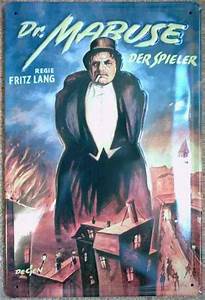 Lang would return to the character in 1933 with The Testament of Dr Mabuse. here, Mabuse is believed dead, but his spectre seems to emerge from an inmate in an insane asylum. A criminal gang carries out his bidding, receiving their orders via radio broadcast. The gang is hunted by Inspektor Lohmann, the police detective of Lang's masterpiece M. Testament features an indictment of the Nazis, through the rantings of Mabuse and the film ended up banned by the Nazi party. Lang would soon leave for France, then England and the US.  Simultaneously, the film had been recorded in both a German and French language version, with slight variations. In 1960, German producer Arthur Brauner convinced Lang to return to the character (in exchange for funding the filming of an unrealized previous production). Lang produced the 1000 Eyes of Dr Mabuse, where the character is again believed dead, but his spectre arises. the police hunt for him, while an American businessman saves a woman from committing suicide, on Mabuse's orders. The hotel where they are at turns out to be filled with surveillance devices, created during the war, to spy on diplomats. Mabuse uses the system to keep tabs on persons of interest. The film is a mix of horror and crime; but, it would launch an entire new series of Mabuse films. 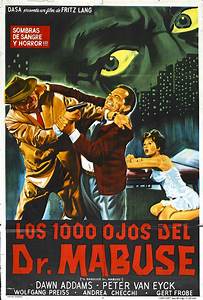 In The Return of Dr Mabuse, Inspektor Lohmann finds himself working with an American agent, Joe Como. By this point, the spy trappings are becoming more prominent, as Mabuse is running his organization from a prison, masquerading as a prison doctor. This led to further films in the series, with Mabuse using fantastic devices to carry out his dreams of conquest, while opposed by police and government agents, using such devices as an invisibility machine and a death ray. Meanwhile, another detective series, Jerry Cotton, is turned into a series of films...  These were more crime films, though they tread into Eurospy territory, as Bond had blurred the lines between master criminals and espionage masters. Meanwhile, France had similar goings on, including the series of films surrounding the character lemmy caution, played by Eddie Constantine. Again, they tread more in the detective/crime genres; but, had aspects of the super spy film. The most famous (or infamous) is Jean-Luc Goddard's sci-fi Alphaville, where a rather dour Lemmy caution battles against a super computer, in a dystopian society. It was one of the New Wave films that garnered much attention in the period, despite making little sense as a narrative. On the lighter end of the spectrum was a trilogy of films reviving the French pulp master criminal Fantomas, with Jean Marais in a dual role as Fantomas and the journalist fandor, who hunts for him. Comedic actor Louis de Funes is Commissioner Juve, the police officer hunting Fantomas. Marais, as Fantomas, appears wearing a bizarre latex mask, which makes him nearly featureless; and, at one point, frames Fandor by taking his identity... The Bond films specifically influenced the revival of the character and the style of the films. A sequel followed, Fantomas Unleashed... As you can see, Fantomas' lair, his men and gadgets like his flying Citroen are straight out of the Bond films. Fandor is the heroic figure, while Juve provides the comedy. A third film, Fantomas vs Scotland Yard, would follow, though it lacks the scope of the other two films. The first two films are great fun, with plenty of excitement and some real comedy, often lacking in many of the Eurospy films. The third is an attempt to mix horror elements, with uneven success. The formula was pretty much played out and that would be it for the villain. Following in these footsteps would be Italian films, based on fumetti (comics0, including Diabolik and Kriminal... Diabolik (Danger: Diabolik, in the US) featured John Phillip Law as the master thief, who was one of many descendants of Fantomas. Marisa mel is Eva Kant, his lover, while terry Thomas puts in a cameo as a government minister. Diabolik runs afoul of Inspector Ginko, who tries to stop his crime wave, and Valmont, a crime lord who wants Diabolik killed, to get police pressure off his mob and front businesses. The film was directed by mario Bava, with a score from Ennio morricone. It's great fun, no matter what MST3K said. Kriminal was a rival master thief and he got two films. Again, the Bond films affected the style of these, though the emphasis was more on crime and the caper (especially Diabolik). Next time, we will wrap up the 60s with a smorgasboard of Eurospy films and Japanese film and tv, which would provide fodder for the Mysties. Come on back as we look at Secret Agent Super Dragon, Danger Death Ray, Mighty Jack and a film known in Japan as Key of Keys, which would get a satiric makeover by an American comic. |
|
|
|
Post by codystarbuck on Oct 16, 2019 1:40:50 GMT -5
So, we finish off the 60s with a bit of spy goofiness. There were spy parodies and then there were just plain bizarre films; and, in some cases, there were unintentionally goofy films. Most of this batch of films comes to us by way of MST3k. We start of with Secret Agent Super Dragon... American actor Ray Danton (George Raft Story, The Rise and Fall of Legs Diamond) stars as Bryan Cooper, aka Super Dragon. He's called out of retirement after a buddy is killed, investigating a drug ring that involves college kids. The drug is being administered through chewing gum and the plot takes Super Dragon to Amsterdam. He is assisted by a colleague, known as Baby Face (played by Jess Hahn), who comes up with some pretty stupid gadgets that even have Matt Helm shaking his head. The Mystie version is pretty damn funny, and includes a nice jazz theme for the movie. The film, itself, is pretty dull and Danton is about as bland as they come. Marisa Mel co-starred with John Phillip Law, in Diabolik, a vastly more entertaining film. Next is Danger! Death Ray. A group of enemy agents steals a death ray from some sciency saps (peaceful purposes; what's the peaceful purpose of a death ray?). They escape in a helicopter and submarine that are in no way children's toys. It's up to Tarzan beefcake Gordon Scott to get it back. When it comes to spy films, Gordon Scott is no Lex Barker! I particularly like the underground lab with the corrugated tin walls. Mighty Jack is a compilation film based on the tv series Maiti Jakku, from Eiji Tsuburaya, the man behind the Ultraman series (and it features Masanari Nihei, who was part of the Science Patrol, on the original Ultraman). Mighty Jack is a global security group, protecting the world from danger (ala SHIELD and SPECTRUM, from Captain Scarlet). The group travels around in it's high tech submarine, which also houses jet aircraft. The film splices together the 1st and 6th episodes and we also see the MJ crew carrying an UNCLE Special. This was a kids series, so we can forgive some of the goofiness, though not the rather dull plot. Speaking of Japanese spies, they also jumped in on the bandwagon, with the spy film Key of Keys.  This was actually the 4th in a series of 5 films parodying the Bond movies. Tatsuya Mihashi stars, while YOLT actresses Akiko Wakabayashi and Mie Hama are the damsels in distress/colleagues. The hero is tasked with stealing funds from a group of anti-government guerrillas. It was a big success in Japan, but unknown in the uS, until Woody Allen took the footage, dubbed in his own story and inserted himself at certain points, added the Lovin' Spoonful, and a stripper and gave the world What's Up, Tiger Lily? Here, the plot becomes a battle of a secret recipe for egg salad, pitting agent Phil Moscowitz against Shepard Wong. The best bit is a running gag of curses: "Saracen Pig! Spartan Dog!" Also appearing in the film is Hideyo Amamoto, as a snake handling thug, who is dubbed to sound like Peter Lorre. Smamoto was a veteran of the Godzilla series, as well as Kurasawa's Yojimbo; but might be better known as Dr Who, the villain of Toho's King Kong Escapes (with MechaKong). Dr Who would also appear in the King Kong cartoon series, also done in Japan and show in the US. Amoto was also known in Japan for playing Dr Shinigami, the villain of the original Kamen Rider series. 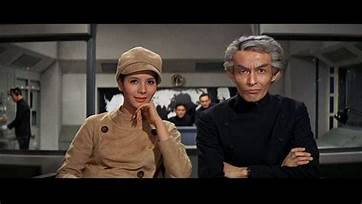 This is just tremendous fun, with some great dialogue gags and vocalizations. It would spawn imitators, such as the syndicated Mad Movies, with the LA Connection, who redubbed Shirley Temple movies into exorcist sequels and Sherlock Holmes films, adding gags about Tina Turner songs. Finally, the strangest spy spoof of them all. All of these films and tv series were trying to cash in on the Bond craze and they ripped off everything. However, this one copied things a bit too closely...  The film was titled OK Connery, aka Operation Kid Brother, aka Operation Double 007. The film stars Connery, Neil Connery; younger brother of Connery, Sean Connery. Baby brother was a plasterer (or bricklayer, according to some accounts) who was hired by an Italian producer to play the brother of a legendary secret agent. What's more bizarre, the producers were able to secure actual Bond actors: Bernard Lee (M), Lois Maxwell (Moneypenny), Anthony Dawson (Prof Dent in Dr No, physical performer for Blofeld, in FRWL), Adolfo Celi (Largo), and Daniela Bianchi (Tatiana Romanova). Celi is the villain, while Lee and Maxwell send out Dr Neil Connery, hypnotist and all-around adventurer on a mission to stop the bad guys, THANATOS. The film rages across Spain and Morocco (and Spain standing in for Switzerland). Neil Connery was fired from a job when his tools disappeared. Somehow, this became the subject of a radio interview, heard by Bind director Terrance Young, who thought Neil sounded just like Sean. He related the story to Italian producer Dario Sabatello, who met with Connery to recruit him to do a spy film. The money on offer beat what he was making as a plasterer and he signed on. While they shot a screen test, the crew kept saying OK Connery, OK, which became the official title. The other actors were recruited with high money offers, with Lois Maxwell remarking that she made more money for her cameo than all of the Bond films, combined. Connery is dubbed with an American accent, though the others appear with their own voices. The film was directed by Alberto De Martino, who had also directed Special Mission Lady Chaplin, with Bianchi (part of the Dick Malloy series of Eurospy films). This thing even has a commando raid, though the commandos in question are in Alpine gear and use bows and arrows, while Adolfo Celi is packed into enough leather to cover a herd of cows (or naugahyde to cover a lounge chair), It's just plain weird; but, in an entertaining kind of way. Reportedly, Sean was furious that Maxwell and the others took part, but forgave them when Maxwell helped pull Neil out of a spot with reporters. Neil wasn't the only Connery to get in on the game, as Sean's son, Jason Connery, played Ian Fleming in a rather fictionalized biopic of Ian Fleming (as in to the point of being almost completely fabricated), called Spymaker. He would also appear in the two Harry Palmer reunion cable films, as Harry's Russian-born son. ironically, Michael Caine's brother Stanley was also in the business, and appears with him in The Italian Job. Next, we leave behind the 60s and the spy boom and look at some 70s attempts at spy fun. we will start with a blend of spy-fi and sci-fi, as an astronaut is recruited to become an agent by a fer special government agency. |
|
|
|
Post by codystarbuck on Oct 16, 2019 1:44:43 GMT -5
Whoops; strike that, reverse it. I have one more entry for the 60s, which bridged into the 70s, to cover, before getting to our sci-fi spy. Come on back and meet David Callan and see a spy who hates his job.
|
|